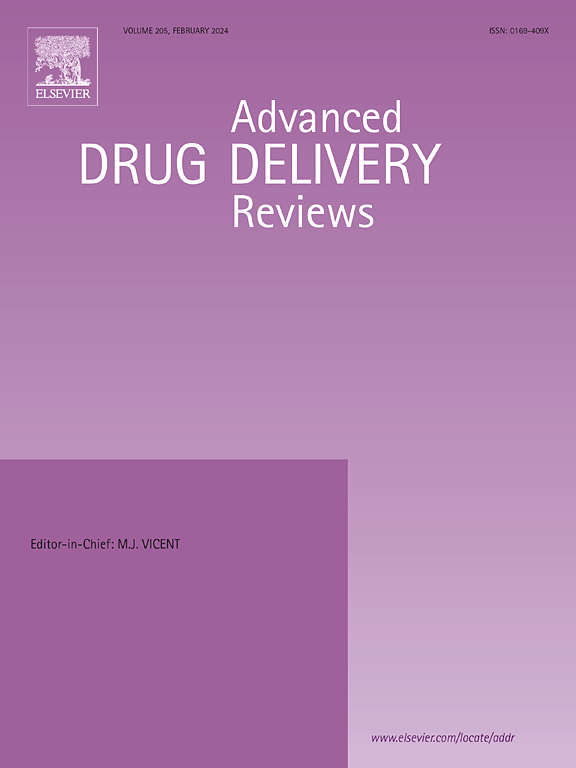昼夜节律和血脑屏障与神经系统疾病药物疗效和递送的交叉
IF 17.6
1区 医学
Q1 PHARMACOLOGY & PHARMACY
引用次数: 0
摘要
昼夜节律通常维持一个24小时的周期,这决定了许多基因和蛋白质的调节,包括但不限于控制血脑屏障(BBB)渗透性的基因和蛋白质。血脑屏障作为循环血液和大脑之间的边界,保护大脑免受有毒物质的侵害,维持体内平衡,调节灌注。重要的是,血脑屏障调节药物进入中枢神经系统(CNS)的功效。新出现的证据表明,昼夜节律障碍、神经障碍和/或血脑屏障破坏之间存在双向关系。这意味着血脑屏障功能受损和昼夜节律失调可能是神经系统疾病的驱动因素和结果。因此,两者都代表了治疗干预的机会,可以预防疾病发展,控制症状或调节疾病进展。本综述旨在描述一系列神经系统疾病(中风、癫痫、创伤性脑损伤)、神经退行性疾病(阿尔茨海默病、帕金森病)和精神疾病(重度抑郁症、精神分裂症)中血脑屏障和昼夜节律的变化。我们还描述了防止血脑屏障和昼夜节律功能障碍的治疗方法,超越血脑屏障的方法,以及通过时间治疗策略增强药物疗效的方法。本文章由计算机程序翻译,如有差异,请以英文原文为准。


The intersection of circadian rhythms and the blood-brain barrier with drug efficacy and delivery in neurological disorders
Circadian rhythms typically maintain a 24-hour cycle which determines the regulation of many genes and proteins including, but not limited to, those which control the permeability of the blood brain barrier (BBB). The BBB acts as a boundary between circulating blood and the brain, protecting the brain from toxicants, maintaining homeostasis, and regulating perfusion. Importantly, the BBB regulates the efficacy of drug delivery into the central nervous system (CNS). Emerging evidence demonstrates a bi-directional relationship between circadian rhythm dysfunction, neurological disorders, and/or BBB disruption. This means that impaired BBB functions and circadian rhythm dysregulation can be both the driver of neurological disease and the result. As such, both represent an opportunity for therapeutic intervention which can prevent disease development, manage symptoms, or mediate disease progression. This review seeks to describe the changes in both the BBB and circadian rhythms in a series of neurological (stroke, epilepsy, traumatic brain injury), neurodegenerative (Alzheimer’s disease, Parkinson’s disease), and psychiatric disorders (major depressive disorder, schizophrenia). We also describe therapeutic approaches for protecting against both BBB and circadian rhythm dysfunction, methods of surpassing the BBB, and bolstering drug efficacy with chronotherapeutic strategies.
求助全文
通过发布文献求助,成功后即可免费获取论文全文。
去求助
来源期刊
CiteScore
28.10
自引率
5.00%
发文量
294
审稿时长
15.1 weeks
期刊介绍:
The aim of the Journal is to provide a forum for the critical analysis of advanced drug and gene delivery systems and their applications in human and veterinary medicine. The Journal has a broad scope, covering the key issues for effective drug and gene delivery, from administration to site-specific delivery.
In general, the Journal publishes review articles in a Theme Issue format. Each Theme Issue provides a comprehensive and critical examination of current and emerging research on the design and development of advanced drug and gene delivery systems and their application to experimental and clinical therapeutics. The goal is to illustrate the pivotal role of a multidisciplinary approach to modern drug delivery, encompassing the application of sound biological and physicochemical principles to the engineering of drug delivery systems to meet the therapeutic need at hand. Importantly the Editorial Team of ADDR asks that the authors effectively window the extensive volume of literature, pick the important contributions and explain their importance, produce a forward looking identification of the challenges facing the field and produce a Conclusions section with expert recommendations to address the issues.

 求助内容:
求助内容: 应助结果提醒方式:
应助结果提醒方式:


